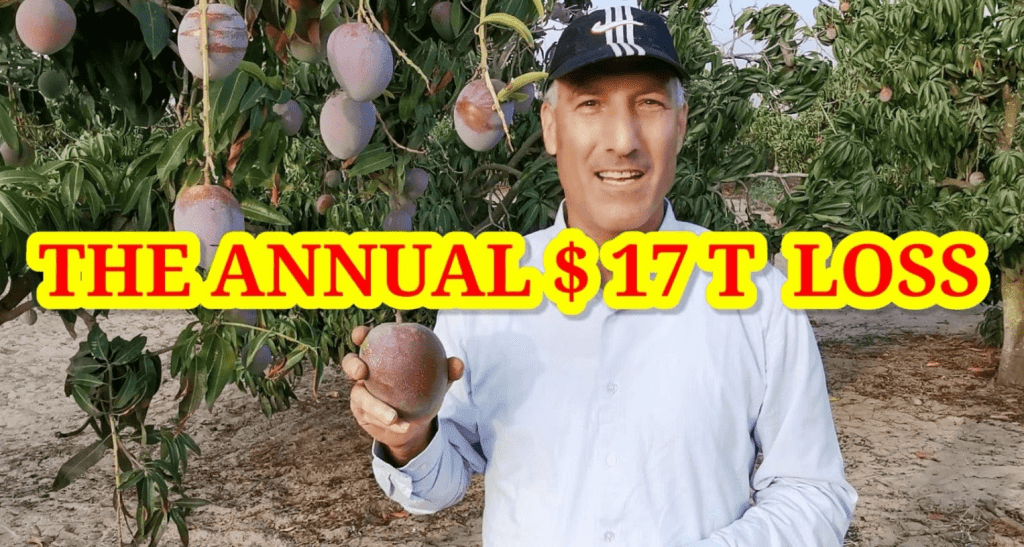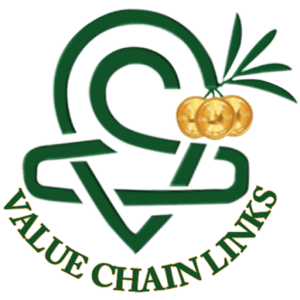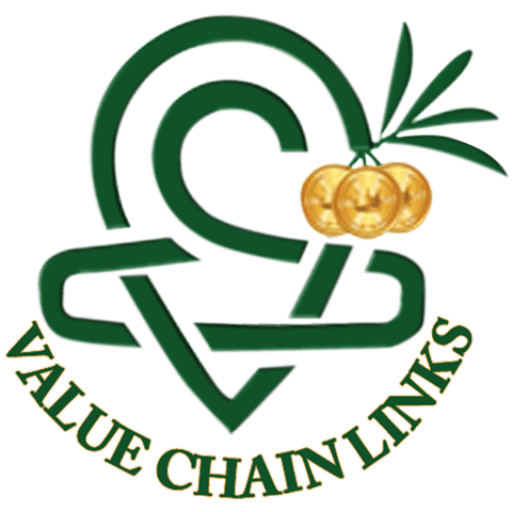
| IF YOU HAD ONLY $1M, WHERE WOULD YOU INVEST IT IN YOUR COUNTRY’S ECONOMY? |
| “When nurtured, agriculture is the solution, not the problem |
If you had $ 1M to invest in anything you like, what would you do with it to maximize its impact?
Here are some ideas for potential investments:
* Small residential building for four families.
* Construction of 250 m of paved road.
* The annual salary for 50 officials.
* Investment in the stock exchange market
* Import 2,092 tons of wheat.
* Import and purchase pesticides and fertilizers for agriculture.
* Purchase a machine for the factory
Then, there is another option –
* Provide support for 1,000 mango growers growing 1,000 hectares to increase export. Today, those farmers lose 50% of their produce due to fruit flies (zero export), and the rest they market locally.
With $ 1M, you can help each of those to immediately increase its commercial production from 2,500 kg to 5,000 kg per hectare and its exports from zero to $3,000,000 plus 2,000,000 kg marketing to the local market.
The total value of $ 4,000,000. Superior ROI!
Note. If the above seems a lot to you, then you better remember that an Israeli mango grower has 50 tons per hectare (most of it of export quality), meaning 50,000 tons per 1,000 ha, valued at well above $ 50M per year!
RUNNING MACRO ECONOMY NUMBERS
Let’s take the above concept and conduct an exercise to calculate how much your farm and your national economic losses annually because you view agriculture as a “Problem” that needs to be “managed” instead of a “Solution” and a national asset.
This exercise is purely business and economic-oriented, without considering the implication of the overall situation – low food availability and safety (usage of chemicals), food prices, poverty, hunger, climate change, foreign currency flow, or farmers living conditions, to mention a few.
ARABLE LANDS?
Globally, there are 1,406 million hectares of arable land.
Out of this, 572 million (40%) are in developed economies (Europe, the Baltic countries, North America and Oceania), where less than 5% of the workforce is employed in agriculture.
The rest, 834 million hectares (60%), are in the less developed economies, i.e., Asia, Africa, and Latin America, where a substantial population percentage – often 20% to 70% – live out of agriculture.
The result is that over 97% of the world’s farmers live in underdeveloped economies. They produce 70% of global food, and 70% of the poor are farmers. Can you believe that!?
HECTARE’S VALUE
The size of a hectare is standard and doesn’t change; however, the VALUE of the production per hectare changes.
In general terms, the rate of income per open field hectare in undeveloped economies is $50 to $500, compared to $5,000 to $50,000 in developed economies.
This is an income gap of X100 – from $4,500 (min.) to $49,950 (max.) per hectare between farmers in the developed economies to others.
GLOBAL & NATIONAL ECONOMIC IMPACT
To facilitate the following calculations, let’s assume the gap is (ONLY!) $ 20,000 per hectare, which resonance with the $20,000 GDP per capita indicator of departure developing economy status.
When we extrapolate the income gap per hectare to the 834 million hectares in the non-developed economies, we find that those countries and farmers annually lose $17 trillion ($16,680,000,000,000)!
STOP.
Take a moment to think about that number –
$16,680,000,000,000
THIS IS THE ANNUAL INCOME LOSS BY THE POOREST COUNTRIES.
While non-developed economies could generate $ 170 trillion over the past decades, they hoped, prayed for, and expected international support of 0.1% of this amount.
Now calculate the number of arable land in your country/farm to know how much you lose yearly because of the agricultural gap.
Make no mistake, “The Agricultural Gap” is not “A Technological Gap,” which is easy to bridge. It is something far more profound and substantial to bridge, which requires a change of Ecosystem and Business Models.
Unless we change, those losses will only grow, as 60% of global arable land reserves are in Africa.
On the other hand, imagine what it will be like when a farmer earns $20,000 per hectare and even more.
Do you still think farmers are the “problem,” not the “solution” to non-developed economies? Which other industry has the potential to generate such huge sums from a never-ending source?
Oh, and I didn’t even start talking about the other positive aspects and impact of agriculture on communities, bio-ecosystems, equality, logistics, trading, economics, food supply independence, future generation education, etc.
THE DOUBLE-EDGED SWORD
Over 97% of the farmers live in non-developed economies, where the purchasing power is 100 times lower than that of a Western farmer.
From the economic point of view, this explains the low interest in the farmers of non-developed economies.
Every morning, when a CEO of an investment (or agro-tech) company weak up, he asks himself, “Where should I invest the efforts and money of my company?”
His answer is straightforward: “I need to continue investing my resources in the Global North, for my risk is lower, and ROI is much higher.” Then he gets on the plane and flies to the EU or the USA if he is not there already.
This explains agro-tech companies’ behavior until now, as it presents the short-sight by those companies and governments, missing the “big picture” and $ billions lost due to mishandling the agro sector.
Companies are not the only ones to lose from this state. Let’s not forget the public and the world’s population, which grows by 83 million yearly (1.1%).
Consumers ask, want, and demand more and better quality food supply, for which they are ready to pay a premium price!
Can you imagine the world without the strong economies of the EU, the USA, or China?
Of course, for a short time, we can survive without any of those economies, but in the long run, we will all suffer.
On the other hand, stronger economies will bring economic prosperity to people, companies, and nations, energizing the global economy.
You may think it is impossible to have the farmers of your country like those in developed economies.
You may be right in the short future, but remember that once those farmers get on the path of improving, their trajectory changes from negative to positive. Soon, they will reach those in advanced economies.
Still skeptical and unsure?
Do you remember the state of the Chinese economy and industry in the 1990s?
If the Chinese made an industrial economic revolution in such a short time, why can’t African countries, India, LATAM, and others, make an industrial agriculture revolution?
Do you see a reason why not?
A CONSCIOUSNESS-CHANGING PROJECT
Oh, and there’s one more little thing.
Let’s assume that 50% of the workforce depends on agriculture for livelihood.
And let’s assume that you enter “A change process,” and yet, 2-5 years later, they still haven’t managed to close the professional-economic gap with the farmers of the developed economies.
And suppose their income increased from $3/day to (ONLY!) $6/day during this period.
Would you consider it a failure? Is it less good than the previous situation? From a national perspective, how would it impact the GDP when 50% of the workforce doubled their income?
You see, sometimes all you need is to give people back the hope and self-confidence that the future can be better and that they can bring change.
The point is not to close the enormous gap that opened within a year but to put the economic train back on track with a trajectory for success.
Farmers and the public in non-developed economies got used to seeing farmers as poor people.
Having a successful project where farmers, once poor, will rapidly increase (double?! and more) their income, thrive, and prosper, is what every non-developed economy, with a significant workforce of farmers, needs.
This is not about technology, which in the 21st century, there is plenty of it.
Economies rise where there is Hope and Self-confidence.
Do you wish to design projects to be successful, to restore hope and self-confidence?
Contact me to see how we can take it to the next level.
| TAKEAWAYS» ASSET – The greatest (unused) economic and national asset in non-developed economies is agriculture.» GAP – Closing the professional and economic gap between the Global South and North agriculture would create plenty of food, jobs, and prosperity and increase global happiness.» NUMBERS TALK – In non-developed economies, the sheer number (and percentage) of farmers out of the workforce means that every change, even if small, in their income massively impacts the GDP.» CONSCIOUSNESS– The goal of national agro projects should be to set a positive example of change, inspiring others and motivating them into action. |
| If you enjoyed the article please share it with friends & colleagues. » SUBSCRIBE « *** Mental and Economic Freedom Are Interconnected. *** |

